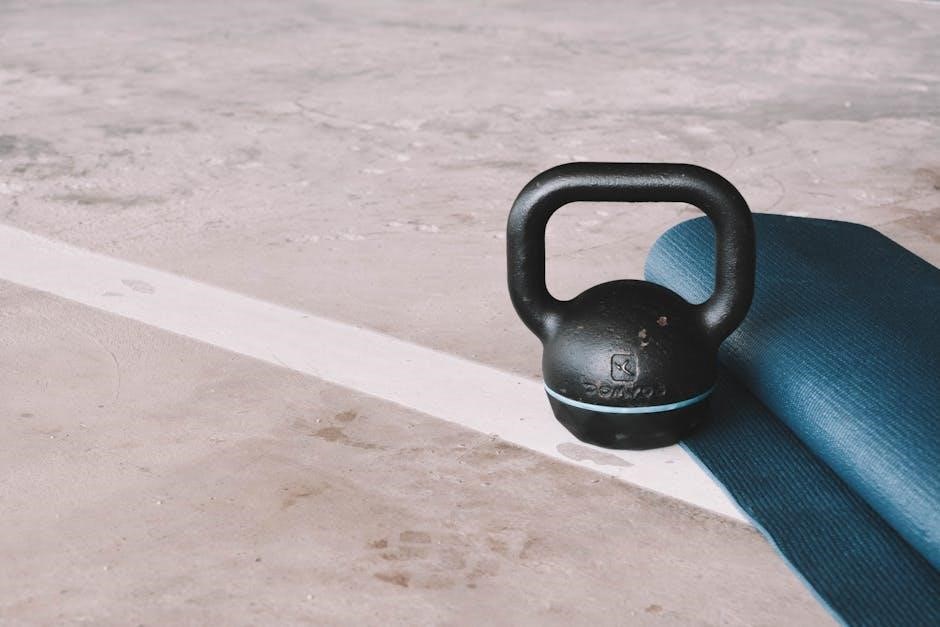Pilates is a holistic fitness method perfect for beginners, focusing on core strength, flexibility, and body awareness. It offers a low-impact approach suitable for all fitness levels, emphasizing controlled movements and breath control. A great way to start your journey is with a beginner-friendly Pilates PDF guide, which provides structured routines and essential exercises like the Hundred and Plank to help you build a strong foundation.
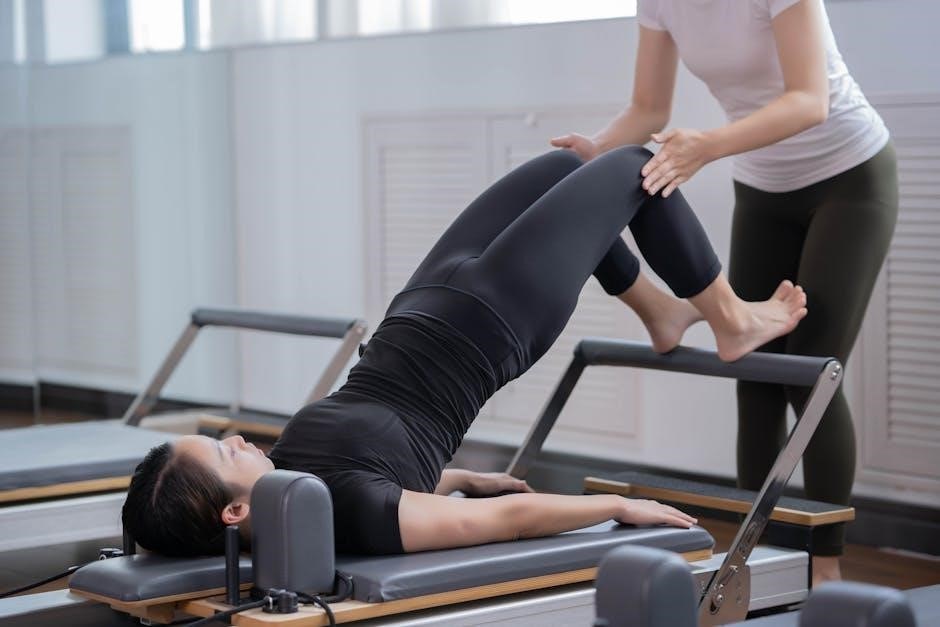
Benefits of Pilates for Beginners
Pilates enhances flexibility, core strength, and body awareness while promoting a mind-body connection. It’s low-impact, suitable for all fitness levels, and improves overall physical and mental well-being.
2.1 Physical Benefits: Core Strength and Flexibility
Pilates focuses on building core strength, which stabilizes the body and improves posture. It enhances flexibility by increasing joint mobility and muscle elasticity, allowing for a wider range of motion. Regular practice also strengthens the muscles, particularly in the abdomen, back, and limbs, leading to better overall physical stability and coordination. These physical benefits help prevent injuries and support daily activities, making Pilates an excellent choice for beginners seeking a balanced workout.
2.2 Mental Benefits: Body Awareness and Mind-Body Connection
Pilates fosters heightened body awareness, helping beginners understand their physical alignment and movement patterns. This practice strengthens the mind-body connection, promoting mental clarity and focus. By emphasizing controlled movements and breath, Pilates reduces stress and enhances overall well-being. Improved body awareness also boosts confidence, encouraging a more mindful approach to daily activities. The meditative aspects of Pilates cultivate a sense of calm, making it a holistic exercise that benefits both the mind and body. Regular practice can lead to better emotional balance and a greater sense of control over one’s physical and mental health.
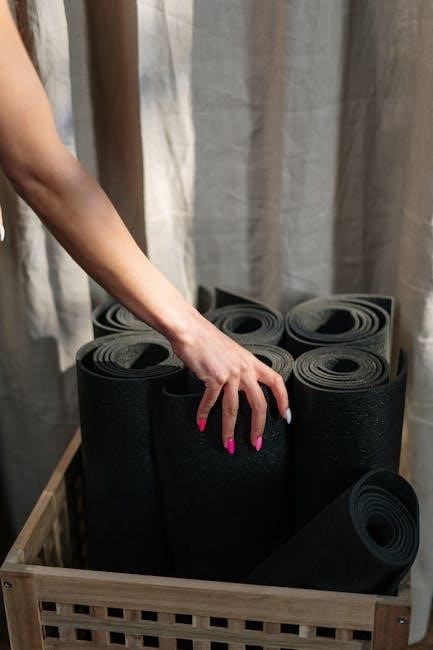
Importance of Warm-Up in Pilates
A proper warm-up is essential in Pilates to prepare the body for movement and prevent injuries. It increases blood flow, flexibility, and muscle readiness, ensuring a safe and effective workout. A gentle warm-up, such as light cardio or dynamic stretches, helps activate the core and improve joint mobility. This initial phase also mentally prepares beginners, fostering focus and breath awareness. By incorporating a warm-up, you set the foundation for a productive and injury-free Pilates session. It’s a crucial step that enhances overall performance and helps beginners transition smoothly into more challenging exercises.
Top 5 Essential Pilates Exercises for Beginners
The Hundred, Plank, Roll-Up, Single Leg Stretch, and Spine Stretch are foundational exercises that build core strength, improve posture, and enhance flexibility for beginners.
4.1 The Hundred
The Hundred is a foundational Pilates exercise that strengthens the core, improves posture, and enhances breathing techniques. To perform it, lie on your back with knees bent and arms extended overhead. Engage your core, lift your head and shoulders off the mat, and pump your arms up and down for 100 beats. Focus on steady, controlled movements and synchronized breathing. This exercise targets the deep abdominal muscles, promoting stability and body awareness. For beginners, it’s essential to maintain a neutral spine and avoid straining the neck. Over time, this exercise will help improve your posture, balance, and overall core strength.
4.2 Plank
The Plank is a fundamental Pilates exercise that builds core strength, improves posture, and enhances overall stability. Start in a high-push-up position with your hands shoulder-width apart and your body in a straight line from head to heels. Engage your core, pull your belly button toward your spine, and hold the position without letting your hips sag. Focus on controlled breathing, inhaling for 4 counts and exhaling for 4 counts. For beginners, start with a modified plank on your knees if needed. Hold for 20-30 seconds and gradually increase the duration as you build strength. This exercise targets the abdominals, obliques, and shoulder muscles, promoting a strong, stable core and better body alignment.
4.3 Roll-Up
The Roll-Up is a classic Pilates exercise that targets the abdominal muscles while improving flexibility and spinal mobility. Lie on your back with legs extended, arms overhead, and engage your core. Inhale deeply, then exhale as you slowly lift your head, shoulders, and arms off the mat, curling up toward your toes. Keep the movement controlled and avoid jerking. If needed, use a resistance band or strap under your feet for support. Focus on using your abdominals to lift rather than momentum. Roll back down slowly to the starting position. This exercise strengthens the core, enhances posture, and improves coordination. Begin with 5-8 repetitions and increase as your strength and control improve.
4.4 Single Leg Stretch
The Single Leg Stretch is a Pilates exercise that enhances core stability, flexibility, and coordination. Lie on your back with legs extended, arms at your sides, and engage your core. Lift your head and shoulders slightly off the mat, keeping the neck long. Inhale as you draw one knee toward your chest, holding onto your knee with your hand. Exhale and slowly extend the leg away, keeping it straight, while bringing the other knee toward your chest. Alternate legs in a smooth, flowing motion, maintaining control throughout. Focus on steady breathing and avoid arching your back. Perform 8-10 repetitions on each leg. This exercise strengthens the abdominals, improves circulation, and promotes a sense of rhythm and balance in the body.
4.5 Spine Stretch
The Spine Stretch is a foundational Pilates exercise designed to improve flexibility and posture. Sit tall with your legs straight, feet hip-width apart, and arms extended forward at shoulder height. Engage your core, keeping your shoulders relaxed and away from your ears. Inhale deeply, then exhale as you fold forward from your hips, reaching toward your toes. Keep your knees slightly bent if necessary to avoid discomfort. Hold the stretch for a few breaths, feeling the length in your spine and hamstrings. Inhale to return to the starting position. Repeat 5-8 times. This exercise enhances spinal mobility, promotes proper alignment, and relieves tension in the lower back. Focus on controlled movements and deep breathing to maximize its benefits.
Equipment Needed for Pilates
Pilates can be practiced with or without equipment, making it accessible for everyone. For beginners, a good-quality exercise mat is essential for comfort and grip during mat-based exercises. Additional equipment like resistance bands, magic circles, or small props such as pillows or towels can enhance your workout. While equipment like the Reformer or Cadillac offers advanced options, they are not necessary for starting. Beginners can effectively practice Pilates with minimal gear, focusing on bodyweight exercises and proper form. Investing in a comprehensive Pilates PDF guide can also provide detailed instructions and equipment setups, helping you make the most of your practice. Start simple and gradually explore more tools as you progress in your journey.
Finding a Good Pilates PDF Guide
Finding a good Pilates PDF guide is essential for beginners, as it provides structured routines and clear instructions. Look for guides that include detailed descriptions, images, and step-by-step breakdowns of exercises. A comprehensive PDF should cover foundational movements, breathing techniques, and modifications for different fitness levels. Many resources online offer free or paid Pilates PDFs, so choose one that aligns with your goals. Ensure the guide is created by certified instructors to guarantee accuracy and safety. A well-designed Pilates PDF will help you stay motivated and guided as you progress in your practice, whether you’re focusing on mat work or equipment-based exercises.
Tips for Effective Home Practice
For an effective home Pilates practice, start by creating a quiet, distraction-free space. Invest in a good-quality mat and props like resistance bands or a Pilates ring. Always prioritize proper form to avoid injuries, using guidebooks or PDFs for clear instructions. Modify exercises to suit your fitness level and focus on core engagement and breathing techniques. Establish a consistent routine, beginning with a warm-up and progressing to more challenging movements. Stay hydrated, listen to your body, and set realistic goals to maintain motivation. Regular practice, even 10–15 minutes daily, can lead to noticeable improvements in strength and flexibility. Use a Pilates PDF guide to plan your workouts and track your progress effectively.
Common Mistakes to Avoid
When starting Pilates, it’s essential to avoid common mistakes to ensure safety and effectiveness. One of the most frequent errors is poor form, which can lead to injuries. Always prioritize proper alignment and engage your core correctly. Another mistake is not modifying exercises to suit your fitness level—listen to your body and adjust as needed. Overexertion is also a pitfall; focus on controlled movements rather than speed. Neglecting to breathe properly can disrupt your technique, so practice Pilates breathing techniques consistently. Lastly, rushing through exercises can undermine their benefits. Use a Pilates PDF guide to review proper form and avoid these mistakes for a safe and effective practice.
Importance of Core Engagement
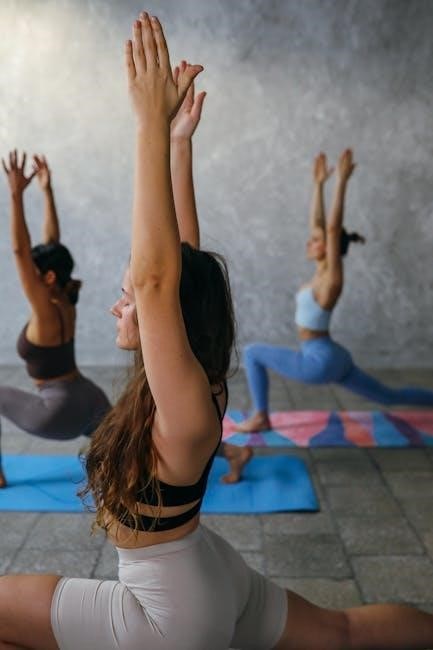
Breathing Techniques in Pilates
Breathing techniques are a cornerstone of Pilates, enhancing oxygen flow and promoting relaxation. Proper breathing helps connect the mind and body, supporting core engagement and precise movements. Inhale during preparation phases and exhale during effort to maintain control and stability. For example, inhale to prepare for the Hundred and exhale as you curl up. Breathing patterns vary slightly depending on the exercise but always prioritize deep, rhythmic breaths. Consistent practice will help you master these techniques, improving your overall Pilates experience. A good Pilates PDF guide will often include breathing tips to help beginners synchronize their breath with movements for better results and a more mindful practice.
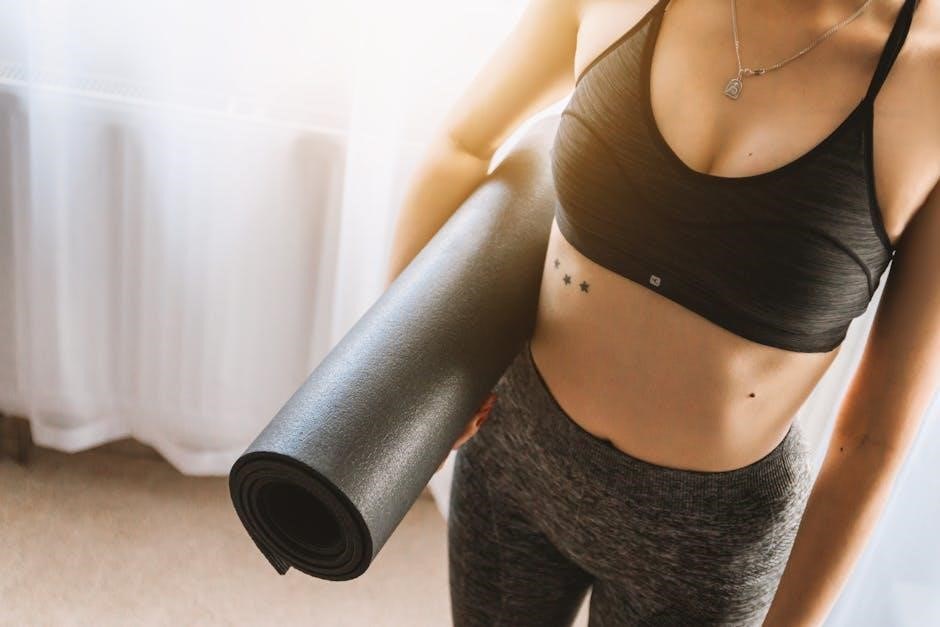
Progressing Safely in Your Practice
Progressing safely in Pilates requires patience, body awareness, and consistent practice. Start with basic exercises and gradually modify or advance as your strength and flexibility improve. Always warm up before beginning and cool down afterward to prevent injuries. Focus on proper form and engagement, especially of the core, to ensure each movement is effective and safe. Use props like resistance bands or Pilates circles to add challenge without overexertion. Listen to your body and rest when needed—quality over quantity is key. A well-structured Pilates PDF guide can help you transition smoothly between levels, offering clear instructions and modifications to suit your progress.
Congratulations on completing your introduction to Pilates! With consistent practice, you’ll enhance strength, flexibility, and overall well-being. Remember, Pilates is a journey, not a race—celebrate small victories and stay committed. Use a beginner-friendly Pilates PDF guide to stay motivated and track your progress. Incorporate mindfulness and breathing techniques to deepen your practice. Surround yourself with supportive resources and communities to keep you inspired. Embrace the transformative power of Pilates and enjoy the positive changes it brings to your body and mind. Keep moving forward and enjoy the journey toward a stronger, healthier you!

